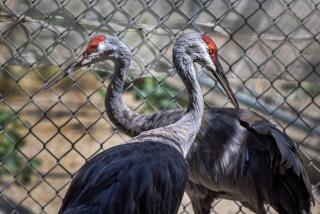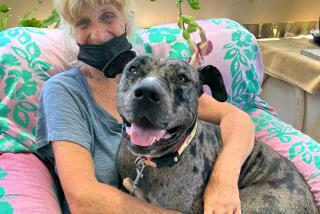Pets also need help in Charley aftermath
- Share via
PUNTA GORDA — Animal rescue after Hurricane Charley hasn’t just been a matter of helping storm victims with their dogs and cats. Far from it.
Since teams of animal disaster specialists began arriving here Sunday, they’ve had their hands full with calls involving lions, goats, parrots and macaws, a days-old squirrel, baby raccoons, cows, horses, a ferret, llamas and cobras.
“A to Z” said Laura Bevan, director of The Humane Society’s southeast regional office in Tallahassee. “If we haven’t seen it yet, we’ll probably see it before we leave.”
That’s on top of the dozens of dogs and cats that have been brought in for care or a temporary home. Hundreds of dogs and cats that have been found since Charley hit have been sent to shelters in counties outside the disaster area and if not reunited with their owners will be put up for adoption.
Bevan is among about 100 people taking part in the animal emergency response, which includes local, state and federal help. People are driving through neighborhoods trying to find pet owners in need, delivering pet food, making rescue calls, providing emergency veterinary and kennel services and setting up three stations to take in and provide care for animals.
The Federal Emergency Management Agency has even brought in 35 veterinarians from as far away as Ohio, Utah, Oklahoma and elsewhere to take treat to animals in the 25 counties declared federal disaster areas.
At a compound set up next to a baseball field, Lloyd Brown held up one of two month-old raccoons rescued after Charley hit Friday and fed it through a syringe. The tiny raccoon lapped at the milky liquid with its paws spread out and eyes like black BBs staring at Brown.
Brown put it in a crate with its sibling, then picked up a hairless animal with a teensy tail and bulging eyes, lids still shut tight. It was smaller than Brown’s pinky and not easily recognizable to a non-animal expert.
“You didn’t get enough, huh?” Brown said when the squirrel squirmed for more food. It was born right around the same time Charley struck.
Just after he finished feeding the wild animals rescued after the hurricane, a group that also includes two small doves, Brown jumped in his truck to respond to a call seeking help for dozens of birds.
He arrived at the home of Rich Naegeli, who was the first zoo director at Busch Gardens in Tampa. He found 60 exotic birds, from parrots and macaws to the a pair of rare Australian slender bill corellas -- beautiful white birds with orange necks.
Naegeli, who has also run zoos in Saudi Arabia and Boston, also has four llamas, two horses, two dogs and a number of roosters and rabbits running around his expansive property on the far east edge of Charlotte County.
Naegeli and his wife, Dolly, didn’t want the animals removed from the property, but they needed help. Their electricity has been out for four days and they can’t pump water from their well for the animals -- or for themselves and their daughter and grandson.
Brown tries and fails to hook the roaring generator up to the water pump as the parrots and macaws screech loudly. He offers advice on finding an electrician, saying that would be the best solution.
“If you don’t get the pump working, let us know and we’ll get you water,” Brown says before leaving.
On the way back to the animal rescue compound, he stops to check on several horses in fields along the way.
“That left leg -- I’d like to see him walk,” he said, watching a brown horse standing under a tree with its leg slightly raised. After a minute, the horse puts his leg down and takes a couple steps. “OK,” Brown said before driving on.
Also along the road is a serpentarium, where researchers take the venom from about 400 poisonous snakes. It’s not the kind of place that you want to see severely damaged during a Category 4 hurricane.
“All of his snakes are accounted for. That’s one of the places we checked,” Brown said.
Among the other calls animal workers have received were reports of 15 goats wandering near U.S. 17. Two were caught. Officials also chased down two lions that were also roaming the same highway. And next to the animal compound, about 10 cows were penned into a youth baseball field that had building debris strewn along its fences, including one that insisted on hanging out in the dugout.
“They were wandering the streets, causing trouble,” Bevan said of the cows. “We had to have the fire department come over her and bring them water because they drank so much.”
Among other cow concerns was making sure dairies had generators to milk their cows.
“If they don’t get milked within 24 hours, they’re no long milk producers and they have to be sent out for slaughter,” Bevan said.
Then, of course, there’s the cats, dogs and an occasional pet ferret that need help.
Bruce Mathews brought his albino Doberman, Mandy, in after she suffered severe ant bites.
“This is a beautiful place,” he said, point his hand up at a trailer truck, two RVs, and stacked crates, pet food and cat litter. “I’m just happy they’re here.”
Next to arrive was Kip Rhoten, who rode out Charley in his bathroom with his two dogs, Storm and Thunder. Storm howled as the winds whooshed outside and Thunder panted heavily. All survived in good shape and Rhoten’s house made it through with only minor damage.
But the day after the storm, the dogs were in the backyard while Rhoten was away and someone came by and opened the gates. He was at the station seeking help finding them. A volunteer took down descriptions of the dogs and offered to help print and distribute fliers.
“I keep my fingers crossed,” Rhoten said, adding that he would have rather have had more of his home damaged than lose his dogs. He felt comforted that there were people ready to help him.
“This is great. Here you’ve got people who have been killed, people who have lost their homes, but I still have a place to come where people want to help. I like that.”
More to Read
Sign up for Essential California
The most important California stories and recommendations in your inbox every morning.
You may occasionally receive promotional content from the Los Angeles Times.













